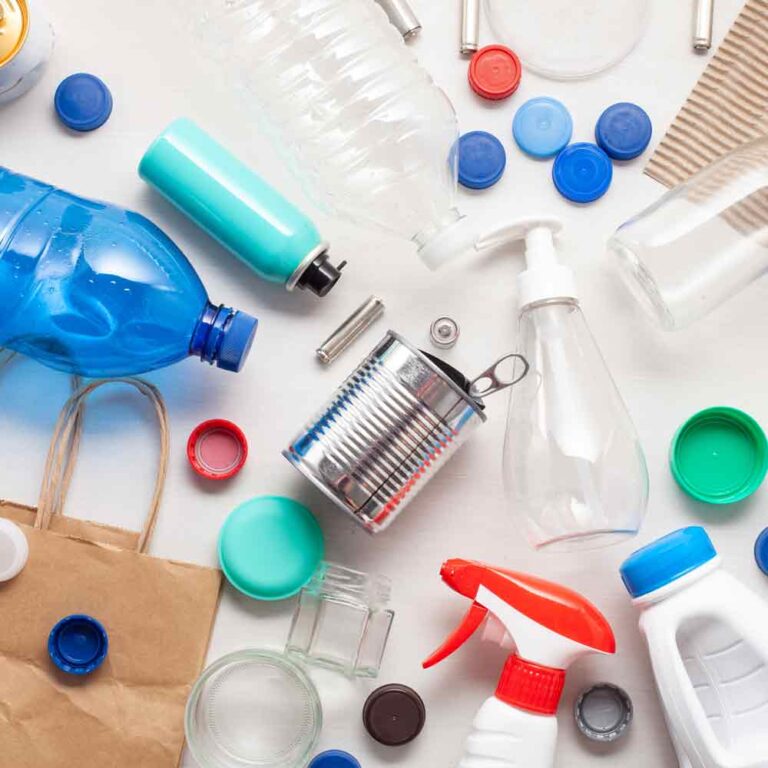In a time when every action has an impact on our planet, it is important to make wise and sustainable decisions. This article makes reducing waste a breeze. We have compiled a collection of clever and easily implementable tips for waste reduction in everyday life. Join in and discover how you can make a significant contribution to environmental protection in your daily life with just a few changes – simple, effective, and with immediate noticeable effects.
- Buy only what you really need: Many things are purchased and then sit at home for years, rarely or never used, until they are discarded. This results in unnecessary waste and unnecessary spending. So, before every purchase, consider whether you really need it and commit to waiting (for example, if you want to buy a new gadget) for at least a week before making the purchase. You’ll often find that after a week, the desire is gone.
- Plan your meals and make a shopping list: Many food items are wasted because we shop without a plan and then don’t use the food. Sit down before every shopping trip and carefully plan the meals you want to cook, and make a list of exactly what you need for them. Also, always make sure to use perishable foods that you can’t consume in one meal for another dish. When you’re at the supermarket, stick to your shopping list and only buy what’s on it.
- Repair instead of buying new: Many things can be repaired more easily and inexpensively than you might think. If something breaks, look online to see if you can possibly repair it yourself or inquire with a repair shop about the cost of fixing it. This way, you can reduce waste and help the environment.
- Second-hand instead of new: In second-hand stores or on websites like eBay, you can often buy well-maintained, used items at a reasonable price. This not only saves your wallet and the environment, but also gives the things you buy a second life.
- Rent instead of own: Take advantage of the benefits of the sharing economy. Nowadays, it’s possible to easily and conveniently rent almost anything, from cars and tools to tents. This offers numerous advantages: If you only need certain items infrequently, you can save space in your home and also save money and the environment. Plus, you don’t have to worry about the usual maintenance and upkeep associated with owning things. Furthermore, you have the opportunity to always access up-to-date and well-maintained items without having to maintain them yourself. Use the opportunities of the shared economy to live more sustainably and flexibly meet your needs.
- Use tap water: Avoid plastic bottled water and instead drink tap water – an environmentally friendly and cost-effective alternative. For lovers of sparkling water, there are devices like Sodastream*, which allow you to easily make sparkling water at home. If you prefer flavored water, startups like Waterdrop* offer a selection of effervescent tablets in various flavors. This eco-friendly practice reduces plastic waste and the need for water bottles that need to be transported, thereby contributing to a reduction in CO2 emissions. This way, you make a valuable contribution to environmental protection and save yourself the hassle of carrying water bottles.
- Use reusable bottles: Although carrying bottles is still necessary, using reusable bottles has clear benefits for the environment. With reusable bottles, you can enjoy your favorite drinks and make an active contribution to waste reduction. Reusable bottles are sturdy, can be used multiple times, and are often made from environmentally friendly materials. Regularly using reusable bottles reduces the amount of single-use plastic and lightens the environmental load. Additionally, many reusable bottles provide better insulation than plastic, keeping beverages cooler or warmer for longer periods.
- Reusable coffee cups for on-the-go: If you regularly drink coffee at coffee shops, consider using a reusable cup instead of a disposable cardboard cup. Many cafes support this environmentally friendly practice and sometimes even offer discounts to customers who bring their own cups. Alternatively, take the time to enjoy your coffee on-site in a porcelain cup. With these simple measures, you effectively contribute to reduce waste and make a valuable contribution to environmental protection. Reusable cups are not only environmentally friendly but also practical, as they often provide good insulation and keep your coffee warm longer.
- Bring your own snacks from home: Avoid buying plastic-packaged convenience products for lunch or snacks by bringing your own snacks from home. Pack them in a reusable container. This not only helps to reduce plastic waste and unnecessary packaging but also saves you money. Homemade snacks are often healthier and can be customized to your taste. Additionally, bringing your own snacks allows you to be creative and try new, delicious snacks during your breaks instead of always buying the same items at the store.
- Opt-out of junk mail: Every year, massive amounts of paper waste are generated from unwanted advertising mailings that often go unread. An effective solution is to use a “No Junk Mail” sticker* on your mailbox. This signals to the mail carriers that advertising brochures and flyers are not wanted at your address. Additionally, you can sign up for specific services to stop the delivery of unaddressed junk mail. It’s also advisable to directly unsubscribe from companies that send you addressed mail. These actions not only contribute to environmental protection by reducing unnecessary paper waste but also ensure that your mailbox remains free of unwanted advertisements.
- Cloth diapers for infants: If you have small children, consider using modern cloth diapers instead of disposable ones. Switching to cloth diapers offers both ecological and financial benefits. Cloth diapers are reusable and significantly reduce waste production. Moreover, you save money in the long run, as you don’t have to constantly buy new diapers. Modern cloth diapers come in various designs and sizes, often with improved absorption capabilities and ease of use. This makes them not only eco-friendly but also practical and comfortable for your child.
- Solid soap and shampoo bars: Another way to reduce waste is by switching from liquid soaps and shampoos in plastic bottles to solid soap and shampoo bars. These products are usually available in eco-friendly, plastic-free packaging or even without packaging. Solid soaps and shampoo bars are long-lasting and economical alternatives.
- Use reusable bags: Avoid single-use (plastic) bags and always carry a reusable shopping bag with you. Reusable bags are not only environmentally friendly but also generally more durable and long-lasting than plastic bags. They are a practical and sustainable solution to reduce plastic consumption when shopping. They are often made from sturdy materials such as cotton, jute, or recycled plastic, making them an ideal alternative for everyday use.
- Switch to digital bills and statements: An effective way to reduce paper consumption is to switch to digital formats for bills and statements. Most banks and service providers now offer the option to receive documents electronically. This not only reduces paper usage but also makes it easier to organize and find your documents.
- Avoid disposable items: To reduce waste, avoid disposable items such as paper towels, plastic utensils, or cotton swabs. There are reusable alternatives available for almost all disposable products, which are more environmentally friendly and often cost-effective in the long run. Instead of paper towels, you can switch to reusable cloth towels that can be easily washed and reused.
- Use rechargeable batteries: To reduce waste and save money, consider using rechargeable batteries* instead of disposable ones. Rechargeable batteries can be charged and reused hundreds of times, significantly extending their lifespan compared to disposable batteries.
- Digital reading: Prefer e-books, online newspapers, and magazines over printed editions to reduce paper waste. Digital reading formats offer numerous advantages: they are instantly available, require no physical space, and contribute to environmental conservation. Modern e-readers like Kindle provide a reading experience that closely resembles paper and allow you to carry a large library in a compact, lightweight device.
- Use refill packages: Choose refill packages for products such as laundry detergent, cleaning supplies, personal care products, or food instead of buying a new package every time. This option is not only more environmentally friendly by reducing packaging material consumption but can also be more cost-effective. Refill packages typically use less packaging material and are often cheaper in price.
- Buy durable products: Prefer purchasing high-quality, durable products over cheap, short-lived items. While this may initially seem more expensive, it saves money in the long run and is more environmentally friendly. Durable products need to be replaced less frequently, resulting in less waste and resource conservation over time. When selecting such products, it’s essential to prioritize quality, durability, and repairability.
- DIY cleaning solutions: Make your cleaning solutions from natural ingredients like vinegar, baking soda, and citric acid. These household items are environmentally friendly, cost-effective, and effective. Vinegar is an excellent natural cleaner that dissolves grease and disinfects. Baking soda is good for scrubbing and neutralizing odors.
- Avoid printed tickets: Use digital tickets for events, travel, and public transportation to reduce paper waste. Digital tickets are convenient as they can be sent directly to your smartphone or another mobile device, making them readily available.
- Grow your own vegetables and fruits: If you have the opportunity, consider growing your vegetables and fruits, whether in a garden, on a balcony, or even on a windowsill. Easy-to-grow plants like cherry tomatoes and bell peppers are suitable for beginners. Growing your food not only reduces waste but also benefits the environment by reducing transportation distances and associated CO2 emissions.
- Avoid takeout: Instead of using takeout and delivery services, opt to dine in at restaurants or cook your meals at home. This helps reduce packaging waste, as takeout meals are often delivered in disposable containers.






